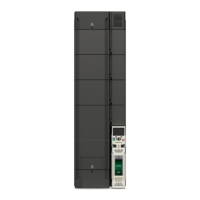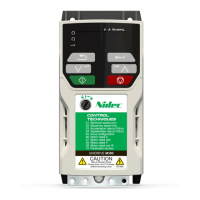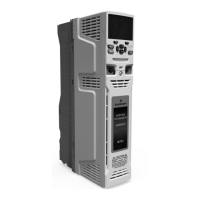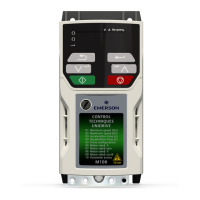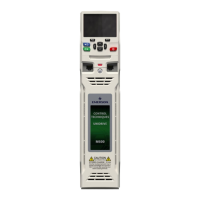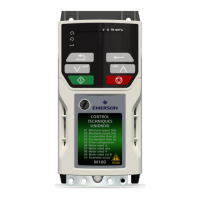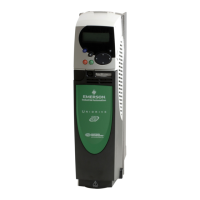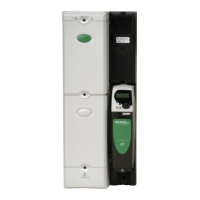for the user to adjust the performance of the controller. The following is a guide to setting the gains for different applications.
Current limit operation
The current limits will normally operate with an integral term only, particularly below the point where field weakening begins. The proportional term is
inherent in the loop. The integral term must be increased enough to counter the effect of the ramp which is still active even in current limit. For example,
if the drive is operating at constant frequency and is overloaded the current limit system will try to reduce the output frequency to reduce the load. At the
same time the ramp will try to increase the frequency back up to the demand level. If the integral gain is increased too far the first signs of instability will
occur when operating around the point where field weakening begins. These oscillations can be reduced by increasing the proportional gain. A system
has been included to prevent regulation because of the opposite actions of the ramps and the current limit. This can reduce the actual level that the
current limit becomes active by up to 12.5%. This still allows the current to increase up to the current limit set by the user.
However the current limit flag (Currentlimitactive (10.009)) could become active up to 12.5% below the current limit depending on the ramp rate being
used.
Torque control
Again the controller will normally operate with an integral term only, particularly below the point where field weakening begins. The first signs of
instability will appear around rated frequency, and can be reduced by increasing the proportional gain. The controller can be less stable in torque control
mode compared to when it is used for current limiting. This is because load helps to stabilise the controller, and under torque control the drive may
operate with light load. Under current limit the drive is often under heavy load unless the current limits are set at a low level.
Supply loss and standard ramp
The d.c. link voltage controller becomes active if supply loss detection is enabled and the drive supply is lost or standard ramp is being used
(RampModeSelect (02.004) > 0) and the motor is regenerating. The d.c. link controller attempts to hold the d.c. link voltage at a fixed level by
controlling the flow of current from the drive inverter into its d.c. link capacitors. The system is forced into current control mode and the output of the d.c.
voltage controller is fed into the current controller as shown below.
Although it is not usually necessary, the d.c. link voltage controller gain can be adjusted with the VoltageControllerGain (05.031). However, it may be
necessary to adjust the current controller gains to obtain the required performance. If the gains are not suitable it is best to set up the drive in torque
control first. Set the gains to a value that does not cause instability around the point at which field weakening occurs. Then revert back to open loop
frequency control in standard ramp mode. To test the controller the supply should be removed whilst the motor is running. It is likely that the gains can
be increased further if required because the d.c. link voltage controller has a stabilising effect, provided that the drive is not required to operate in torque
control mode.
Parameter 04.001 Current Magnitude
Short description Shows the instantaneous drive output current
Mode Open‑loop
Minimum −VM_DRIVE_CURRENT Maximum VM_DRIVE_CURRENT
Default Units A
Type 32 Bit Volatile Update Rate 16ms
Display Format Standard Decimal Places 2
Coding RO, FI, VM, ND, NC, PT
CurrentMagnitude (04.001) is the instantaneous drive output current scaled so that it represents the r.m.s. phase current in Amps under steady state
conditions.
Parameter 04.002 Torque Producing Current
Short description Shows the instantaneous level of torque producing current
Mode Open‑loop
Minimum −VM_DRIVE_CURRENT Maximum VM_DRIVE_CURRENT
Default Units A
Type 32 Bit Volatile Update Rate 1ms
Display Format Standard Decimal Places 2
Coding RO, FI, VM, ND, NC, PT
TorqueProducingCurrent (04.002) is the instantaneous level of torque producing current scaled so that it represents the r.m.s. level of torque
producing current under steady state conditions. TorqueProducingCurrent (04.002) is proportional to the torque produced by the motor provided field
weakening is not active. For field weakening operation the TorqueProducingCurrent (04.002) is boosted for a given level of torque to compensate for
the reduction in the motor flux. The sign of TorqueProducingCurrent (04.002) is defined in the table below.
The Rated Torque Producing Current for the motor is given by:
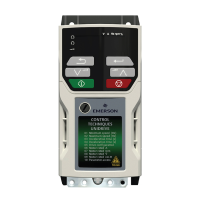
